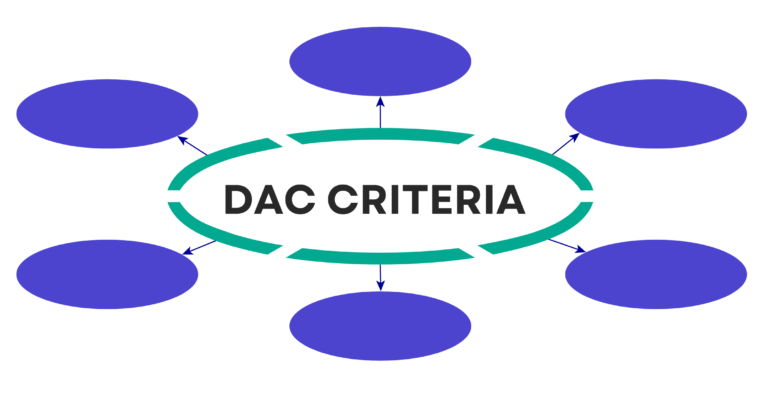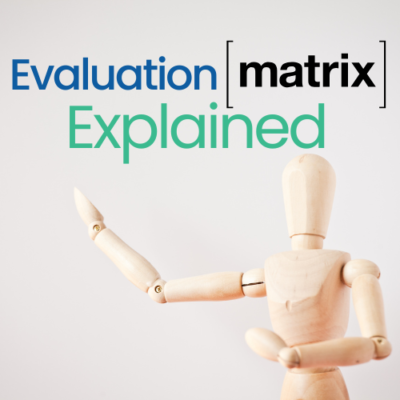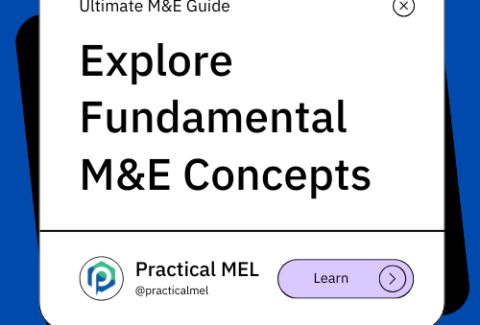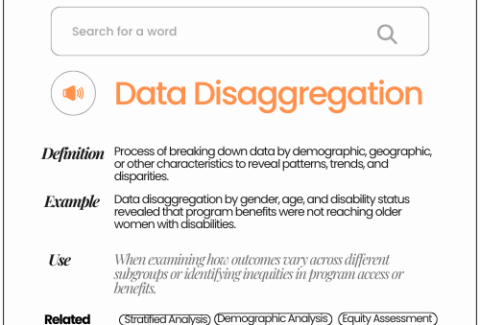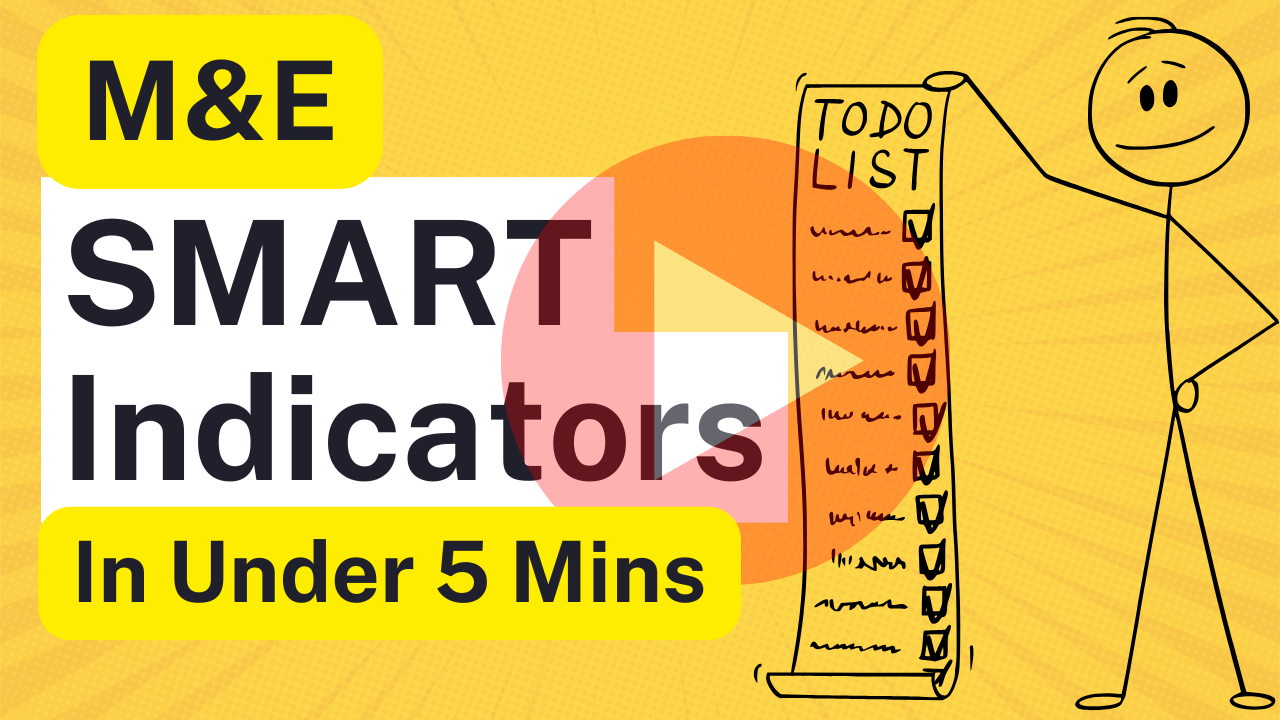The DAC Criteria: Practical Examples and Use in M&E
December 9, 2023 2023-12-11 7:11The DAC Criteria: Practical Examples and Use in M&E
TLDR: The DAC Criteria consist of six fundamental components designed to guide comprehensive M&E assessments. These include Relevance, Coherence, Effectiveness, Efficiency, Impact, and Sustainability. By adhering to these criteria, organizations can ensure that their initiatives not only fulfill their intended purpose but also contribute to lasting developmental progress.
Introduction
With the increasing focus on results and impact in the developmental sector, proficient Monitoring and Evaluation (M&E) practices have become indispensable tools for organizations. Central to M&E is the DAC Criteria, a set of principles established by the Development Assistance Committee (DAC) of the Organisation for Economic Co-operation and Development (OECD). These criteria form the backbone of effective M&E by offering a robust framework for assessing the performance of development interventions. This comprehensive blog will delve into each DAC criterion and explore how it enriches M&E practices.
Understanding the DAC Criteria
The DAC Criteria consist of six fundamental components designed to guide comprehensive M&E assessments. These include Relevance, Effectiveness, Efficiency, Impact, and Sustainability. By adhering to these criteria, organizations can ensure that their initiatives not only fulfill their intended purpose but also contribute to lasting developmental progress.
Relevance pertains to the extent to which an intervention’s objectives align with recipients’ needs, national priorities, and donors’ policies. Coherence evaluates how well an intervention fits within the broader context of other policies, actions, and initiatives within the same sector or cross-sectorally. It seeks harmony and synergy, minimizing overlaps or contradictions, and ensuring that the intervention complements, rather than works against, other efforts. Effectiveness addresses whether the intervention achieved its objectives. Efficiency assesses outputs relative to inputs, translating to how economically resources are converted into results. Impact looks at positive and negative, primary and secondary long-term effects. Lastly, Sustainability is concerned with whether the benefits of an intervention are likely to continue after donor funding has ceased.
Here is a closer examination of each criterion and its application:
Relevance
A developmental intervention must be pertinent to the addressed issues and stakeholders. M&E experts use this criterion to determine if the objectives are still viable and how they align with the needs of the target population. This requires a thorough understanding of the context, stakeholders’ profiles, and a ground-level analysis of the problem. For example, an M&E exercise may reveal that a health intervention needs to focus more on preventive care rather than curative, based on the community’s demographic data and disease prevalence.
Example: In a rural agricultural support program, relevance might be examined by evaluating if the initiative’s objectives align with the farmers’ immediate needs, like access to water during drought seasons, as well as broader agricultural policies and market demand.
How to Use It: Before implementing the program, conduct needs assessments through surveys and interviews with farmers and local stakeholders. Review policy documents and market trends to ensure that the program’s objectives match local requirements. Once the program is underway, maintain an open feedback loop to continuously ensure the program activities remain relevant in a changing environment.
Coherence
Coherence examines the consistency and synergistic qualities of an intervention or program. It assesses the alignment between the intervention and other actions in the same context, checking for harmonization, avoidance of duplication, and contradictions. In essence, coherence ensures that interventions are not isolated but woven into the broader developmental fabric effectively.
Example: When analyzing the coherence of a nutrition program in a region with several ongoing health initiatives, one would examine if the program complements existing efforts, conforms to national health policies, and aligns with international nutrition standards.
How to Use It:
- Policy Review: Begin with a thorough review of relevant policies, strategies, and programs in the sector at both the national and international levels. Understand how these frameworks intersect with your program.
- Stakeholder Mapping and Engagement: Map other stakeholders and interventions in the same space to identify potential overlaps, gaps, or contradictions. Conduct workshops or meetings to align objectives and approaches.
- Alignment Assessment: Assess how the program’s activities and outcomes complement or detract from other stakeholders’ efforts. Does the program duplicate what’s already there, or does it fill a necessary gap? And importantly, does it work in harmony with similar initiatives to amplify overall impact?
- Adaptive Planning: Use the findings of the coherence assessment to inform program design and planning. Ensure that your intervention not only achieves its outcomes but also contributes to a cohesive sectoral strategy.
- Reporting for Coherence: Develop a component in your M&E reports specifically dedicated to documenting how the initiative fits and interacts with the broader policy environment and other sector interventions.
Effectiveness
Effectiveness measures whether an intervention’s objectives have been achieved. M&E practitioners assess this by comparing targets against actual outcomes. They may employ various methodologies such as surveys, focus groups, and case studies to gain insight. For instance, if a water sanitation project aimed to reduce waterborne diseases, disease incidence rates before and after the project would be studied to gauge its effectiveness.
Example: For an educational intervention aiming to improve literacy rates, effectiveness would be assessed by measuring increases in literacy among participants. Evaluators would examine if the program met its target literacy rates and understand the specific program components contributing to these outcomes.
How to Use It: Set clear, measurable objectives (e.g., increase literacy rates by 30% among program participants within two years). Use baseline and endline assessments of literacy rates to measure changes. Adjust teaching methods and materials based on ongoing observations and tests to improve outcomes.
Efficiency
As resources are finite, evaluating efficiency ensures that interventions use resources optimally. M&E measures efficiency by analyzing cost-benefit ratios, comparing alternatives, and gauging whether outcomes were achieved on time and within budget. If an education program delivers high dropout rates despite significant investment, it may signal inefficiency in resource allocation or program design.
Example: An HIV/AIDS awareness campaign’s efficiency could be judged by calculating the cost per individual reached and comparing this to the success rate of participants adopting safe practices. A more efficient program would reach more people and change behaviors at a lower cost.
How to Use It: Track the financial and human resources invested and map these against outputs, like the number of workshops held and individuals reached. Benchmark these figures against similar programs and set efficiency improvement goals for the future iterations of the campaign.
Impact
Impact is arguably the raison d’être of development work. Evaluating impact involves discerning changes which can be attributed directly or indirectly to an intervention, including unintended side effects. M&E experts might use longitudinal studies or control groups to isolate the intervention’s impact. For instance, the long-term economic and social effects of microfinance on a community would be a key focus area for impact evaluation.
Example: An impact evaluation for a women’s empowerment project could look beyond immediate results, like the number of women trained, to assess broader social changes, such as increased participation of women in local governance or changes in gender norms within the community.
How to Use It: Develop a theory of change at the project’s onset to map expected outcomes and impacts. Use mixed methods (quantitative surveys and qualitative interviews or focus groups) post-intervention to assess long-term effects, ensuring the inclusion of direct and indirect changes attributable to the project.
Sustainability
Sustainability ensures that the positive effects of an intervention endure beyond the investment period. Assessing this criterion often involves examining the institutional, environmental, economic, and social factors that affect sustainability. M&E for sustainability might look at the lasting benefits of a capacity-building initiative within a local government institution.
Example: The longevity of a clean water initiative may be measured by the continued functionality of water supply systems after the project ends. It would also consider the community’s capacity to maintain and manage these resources without external assistance.
How to Use It: Evaluate community engagement and ownership throughout the project lifecycle by tracking participation rates in maintenance training and local water management committee activities. Post-project, assess the condition and use of water systems and local capacity to address repairs independently.
Operationalizing the DAC Criteria in M&E
M&E professionals must operationalize these criteria effectively to provide clear, actionable insights. This involves developing explicit questions for each criterion, selecting suitable indicators, and employing robust methodologies for data collection and analysis.
The practical utilization of the DAC Criteria in M&E can enhance clarity and focus in development work. Each criterion comes with its own set of methods, tools, and questions that, when applied diligently, can provide a comprehensive picture of a program’s performance.
Practical Steps:
- Begin with a Strong Framework: Develop an M&E framework that integrates the DAC Criteria from the start. Define what relevance, effectiveness, efficiency, impact, and sustainability mean for your specific context.
- Choose the Right Indicators: Develop clear indicators for each criterion that reflect the specificities of your project and can reliably measure progress.
- Engage Stakeholders: Incorporate the perspectives of all stakeholders including beneficiaries, partners, and funders, to gather a multifaceted view of the program’s alignment and performance.
- Collect Robust Data: Use diverse data collection methods (e.g., surveys, interviews, focus groups, observations) to capture a variety of data points that relate to each DAC criterion.
- Analyze and Reflect: Critically analyze collected data and reflect on project performance against each criterion. Utilize findings to inform decision-making, reporting, and strategic planning.
- Report and Communicate: Communicate findings clearly to stakeholders, ensuring that the insights from applying the DAC Criteria are accessible and actionable.
- Iterate: Use the learnings from each DAC criterion to feed back into the project design and planning process. Continue to refine the M&E approach, adapting as necessary to improve future interventions.
By systematically applying the DAC Criteria, M&E professionals can provide practical, actionable recommendations that enhance the project’s relevance, effectiveness, efficiency, impact, and sustainability. In doing so, they ensure that development interventions are not just well-intentioned but are truly making a measurable difference in the lives of the communities they serve.
Challenges and Considerations
Applying the DAC Criteria is not without challenges. It requires dealing with complex causality, attributing outcomes to interventions amongst many influencing factors, and balancing short-term achievements with long-term changes. A well-rounded application of the criteria should account for these complexities, ensuring that evaluations are contextually appropriate and that recommendations are practical.
The Evolution of the DAC Criteria
The DAC Criteria are continually refined to adapt to the changing landscape of international development. Recent discussions have looked at incorporating elements such as inclusivity, partnerships, and innovation into the criteria to ensure comprehensive assessments that align with the Sustainable Development Goals (SDGs).
Conclusion
The DAC Criteria are quintessential in guiding comprehensive M&E efforts. They offer a nuanced framework that goes beyond superficial analysis and fosters deep understanding, effective resource management, and impactful, enduring interventions. For development practitioners and evaluators, mastering the intricacies of the DAC Criteria isn’t just about conducting proper evaluations; it’s about making a genuine difference in the pursuit of lasting development.
By embracing the depth and breadth of the DAC Criteria, M&E professionals can aid organizations in realizing their visions for change, ensuring that when the curtain falls on a developmental program, it leaves behind a legacy of measurable progress, transformative impact, and the enduring benefit of an insightful journey through Monitoring and Evaluation.

